KIA NIRO HYBRID EV 2022 Owners Manual
Manufacturer: KIA, Model Year: 2022, Model line: NIRO HYBRID EV, Model: KIA NIRO HYBRID EV 2022Pages: 684, PDF Size: 9.67 MB
Page 461 of 684
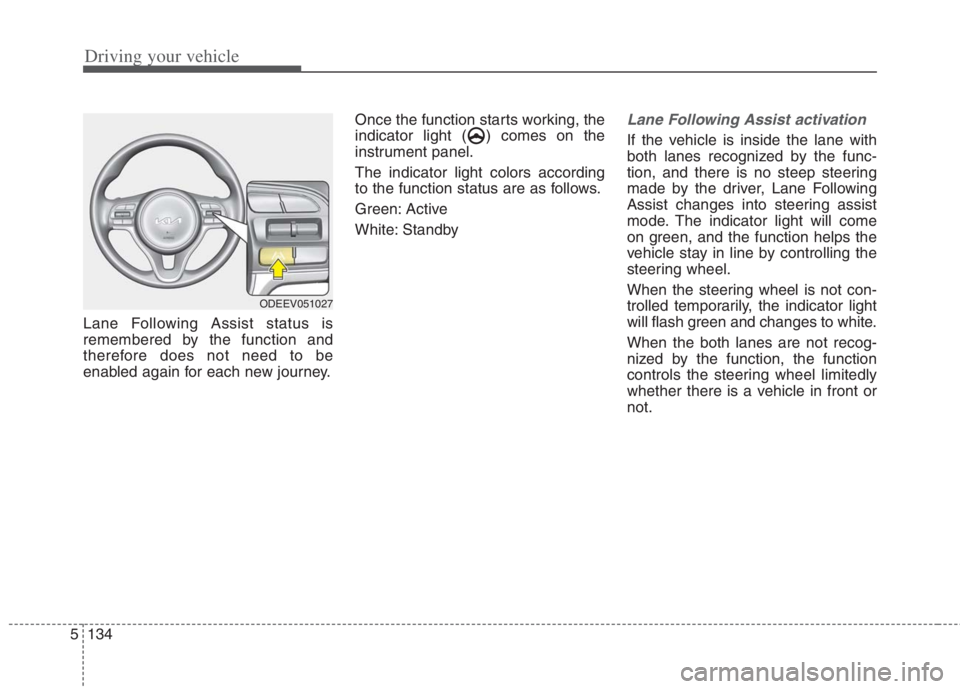
Driving your vehicle
134 5
Lane Following Assist status is
remembered by the function and
therefore does not need to be
enabled again for each new journey.Once the function starts working, the
indicator light ( ) comes on the
instrument panel.
The indicator light colors according
to the function status are as follows.
Green: Active
White: Standby
Lane Following Assist activation
If the vehicle is inside the lane with
both lanes recognized by the func-
tion, and there is no steep steering
made by the driver, Lane Following
Assist changes into steering assist
mode. The indicator light will come
on green, and the function helps the
vehicle stay in line by controlling the
steering wheel.
When the steering wheel is not con-
trolled temporarily, the indicator light
will flash green and changes to white.
When the both lanes are not recog-
nized by the function, the function
controls the steering wheel limitedly
whether there is a vehicle in front or
not.
ODEEV051027
Page 462 of 684
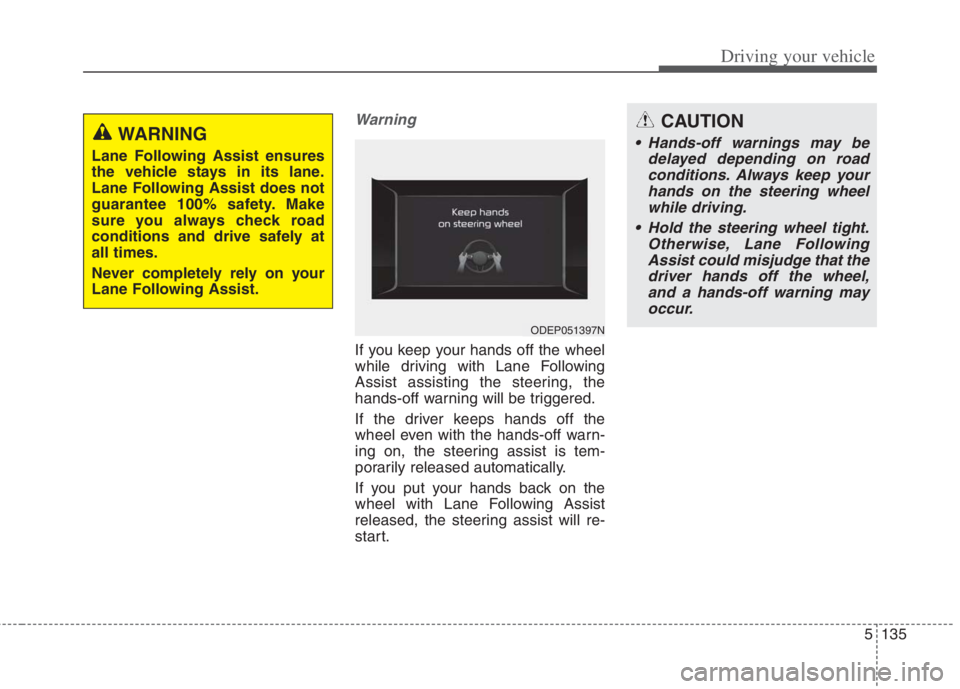
5135
Driving your vehicle
Warning
If you keep your hands off the wheel
while driving with Lane Following
Assist assisting the steering, the
hands-off warning will be triggered.
If the driver keeps hands off the
wheel even with the hands-off warn-
ing on, the steering assist is tem-
porarily released automatically.
If you put your hands back on the
wheel with Lane Following Assist
released, the steering assist will re-
start.
ODEP051397N
WARNING
Lane Following Assist ensures
the vehicle stays in its lane.
Lane Following Assist does not
guarantee 100% safety. Make
sure you always check road
conditions and drive safely at
all times.
Never completely rely on your
Lane Following Assist.
CAUTION
Hands-off warnings may be
delayed depending on road
conditions. Always keep your
hands on the steering wheel
while driving.
Hold the steering wheel tight.
Otherwise, Lane Following
Assist could misjudge that the
driver hands off the wheel,
and a hands-off warning may
occur.
Page 463 of 684
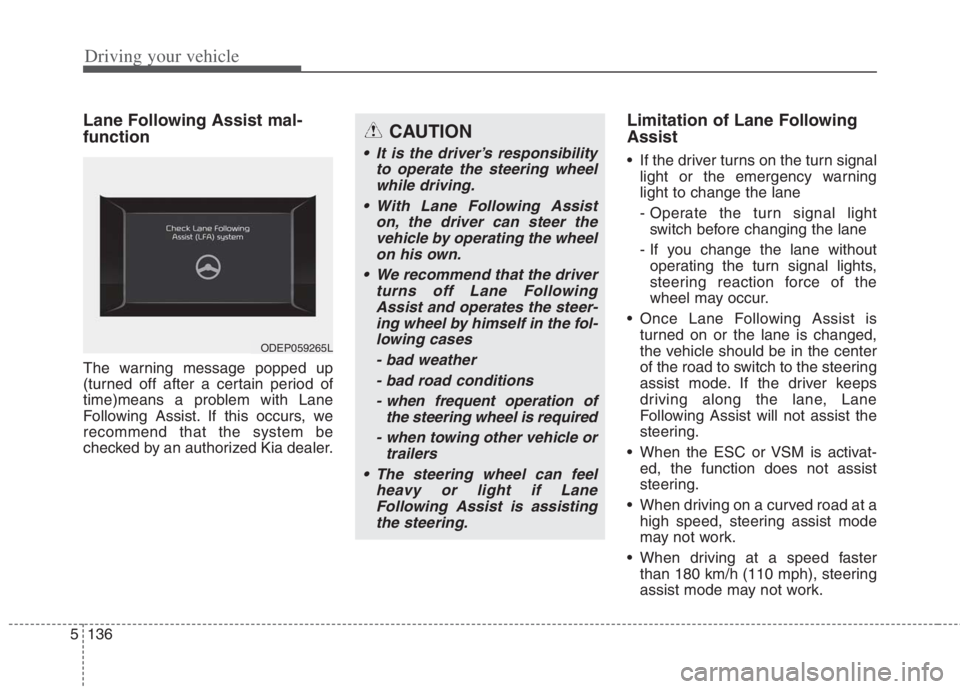
Driving your vehicle
136
5
Lane Following Assist mal-
function
The warning message popped up
(turned off after a certain period of
time)means a problem with Lane
Following Assist. If this occurs, we
recommend that the system be
checked by an authorized Kia dealer.
Limitation of Lane Following
Assist
If the driver turns on the turn signal
light or the emergency warning
light to change the lane
- Operate the turn signal lightswitch before changing the lane
- If you change the lane without operating the turn signal lights,
steering reaction force of the
wheel may occur.
Once Lane Following Assist is turned on or the lane is changed,
the vehicle should be in the center
of the road to switch to the steering
assist mode. If the driver keeps
driving along the lane, Lane
Following Assist will not assist the
steering.
When the ESC or VSM is activat- ed, the function does not assist
steering.
When driving on a curved road at a high speed, steering assist mode
may not work.
When driving at a speed faster than 180 km/h (110 mph), steering
assist mode may not work.
CAUTION
It is the driver’s responsibility to operate the steering wheelwhile driving.
With Lane Following Assist on, the driver can steer thevehicle by operating the wheelon his own.
We recommend that the driver turns off Lane FollowingAssist and operates the steer-ing wheel by himself in the fol-lowing cases
- bad weather- bad road conditions- when frequent operation of the steering wheel is required
- when towing other vehicle or trailers
The steering wheel can feel heavy or light if LaneFollowing Assist is assistingthe steering.
ODEP059265L
Page 464 of 684
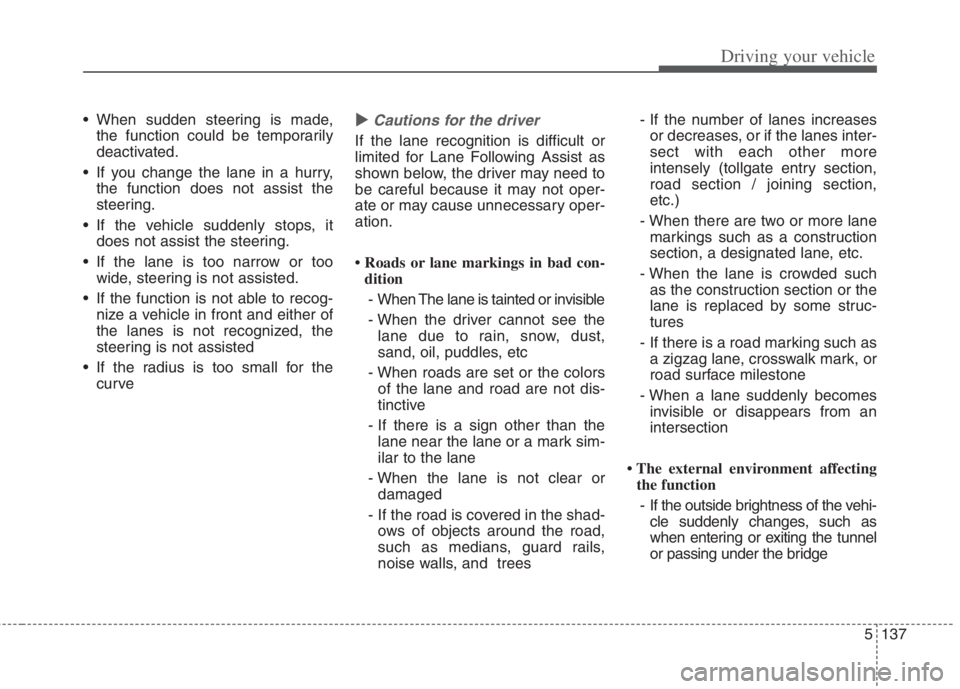
5137
Driving your vehicle
When sudden steering is made,
the function could be temporarily
deactivated.
If you change the lane in a hurry,
the function does not assist the
steering.
If the vehicle suddenly stops, it
does not assist the steering.
If the lane is too narrow or too
wide, steering is not assisted.
If the function is not able to recog-
nize a vehicle in front and either of
the lanes is not recognized, the
steering is not assisted
If the radius is too small for the
curveCautions for the driver
If the lane recognition is difficult or
limited for Lane Following Assist as
shown below, the driver may need to
be careful because it may not oper-
ate or may cause unnecessary oper-
ation.
• Roads or lane markings in bad con-
dition
- When The lane is tainted or invisible
- When the driver cannot see the
lane due to rain, snow, dust,
sand, oil, puddles, etc
- When roads are set or the colors
of the lane and road are not dis-
tinctive
- If there is a sign other than the
lane near the lane or a mark sim-
ilar to the lane
- When the lane is not clear or
damaged
- If the road is covered in the shad-
ows of objects around the road,
such as medians, guard rails,
noise walls, and trees - If the number of lanes increases
or decreases, or if the lanes inter-
sect with each other more
intensely (tollgate entry section,
road section / joining section,
etc.)
- When there are two or more lane
markings such as a construction
section, a designated lane, etc.
- When the lane is crowded such
as the construction section or the
lane is replaced by some struc-
tures
- If there is a road marking such as
a zigzag lane, crosswalk mark, or
road surface milestone
- When a lane suddenly becomes
invisible or disappears from an
intersection
• The external environment affecting
the function
- If the outside brightness of the vehi-
cle suddenly changes, such as
when entering or exiting the tunnel
or passing under the bridge
Page 465 of 684
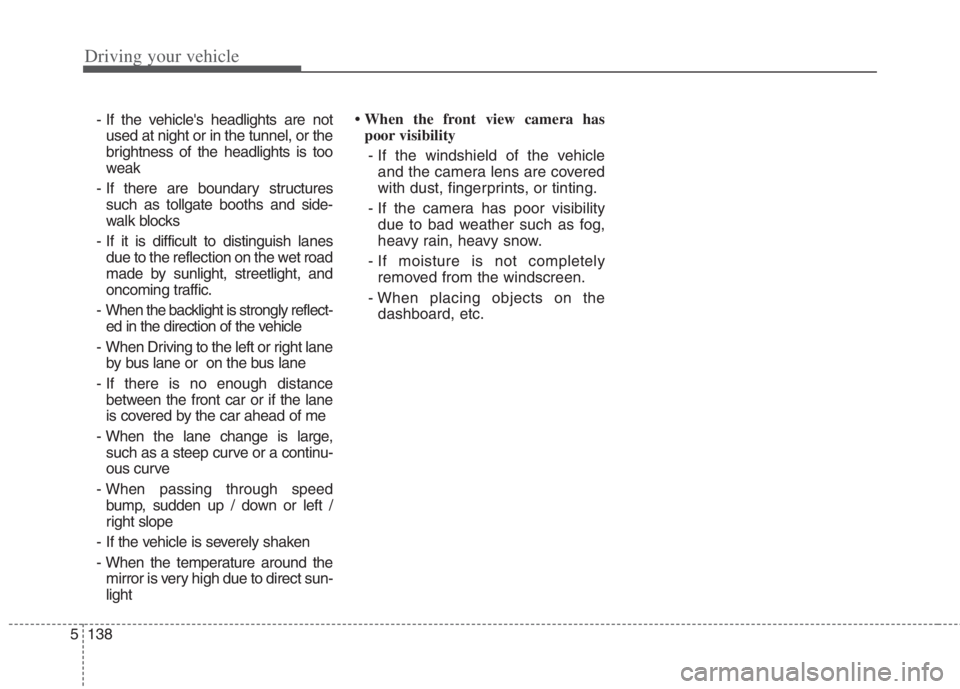
Driving your vehicle
138 5
- If the vehicle's headlights are not
used at night or in the tunnel, or the
brightness of the headlights is too
weak
- If there are boundary structures
such as tollgate booths and side-
walk blocks
- If it is difficult to distinguish lanes
due to the reflection on the wet road
made by sunlight, streetlight, and
oncoming traffic.
- When the backlight is strongly reflect-
ed in the direction of the vehicle
- When Driving to the left or right lane
by bus lane or on the bus lane
- If there is no enough distance
between the front car or if the lane
is covered by the car ahead of me
- When the lane change is large,
such as a steep curve or a continu-
ous curve
- When passing through speed
bump, sudden up / down or left /
right slope
- If the vehicle is severely shaken
- When the temperature around the
mirror is very high due to direct sun-
light• When the front view camera has
poor visibility
- If the windshield of the vehicle
and the camera lens are covered
with dust, fingerprints, or tinting.
- If the camera has poor visibility
due to bad weather such as fog,
heavy rain, heavy snow.
- If moisture is not completely
removed from the windscreen.
- When placing objects on the
dashboard, etc.
Page 466 of 684
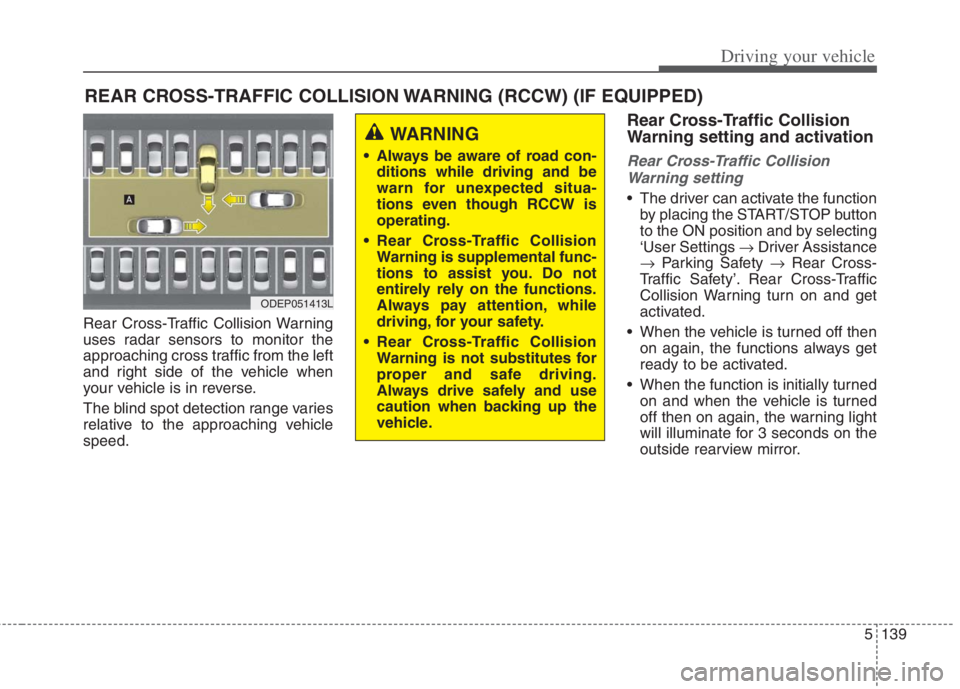
5139
Driving your vehicle
Rear Cross-Traffic Collision Warning
uses radar sensors to monitor the
approaching cross traffic from the left
and right side of the vehicle when
your vehicle is in reverse.
The blind spot detection range varies
relative to the approaching vehicle
speed.
Rear Cross-Traffic Collision
Warning setting and activation
Rear Cross-Traffic Collision
Warning setting
The driver can activate the function
by placing the START/STOP button
to the ON position and by selecting
‘User Settings Driver Assistance
Parking Safety Rear Cross-
Traffic Safety’. Rear Cross-Traffic
Collision Warning turn on and get
activated.
When the vehicle is turned off then
on again, the functions always get
ready to be activated.
When the function is initially turned
on and when the vehicle is turned
off then on again, the warning light
will illuminate for 3 seconds on the
outside rearview mirror.
REAR CROSS-TRAFFIC COLLISION WARNING (RCCW) (IF EQUIPPED)
ODEP051413L
WARNING
Always be aware of road con-
ditions while driving and be
warn for unexpected situa-
tions even though RCCW is
operating.
Rear Cross-Traffic Collision
Warning is supplemental func-
tions to assist you. Do not
entirely rely on the functions.
Always pay attention, while
driving, for your safety.
Rear Cross-Traffic Collision
Warning is not substitutes for
proper and safe driving.
Always drive safely and use
caution when backing up the
vehicle.
Page 467 of 684
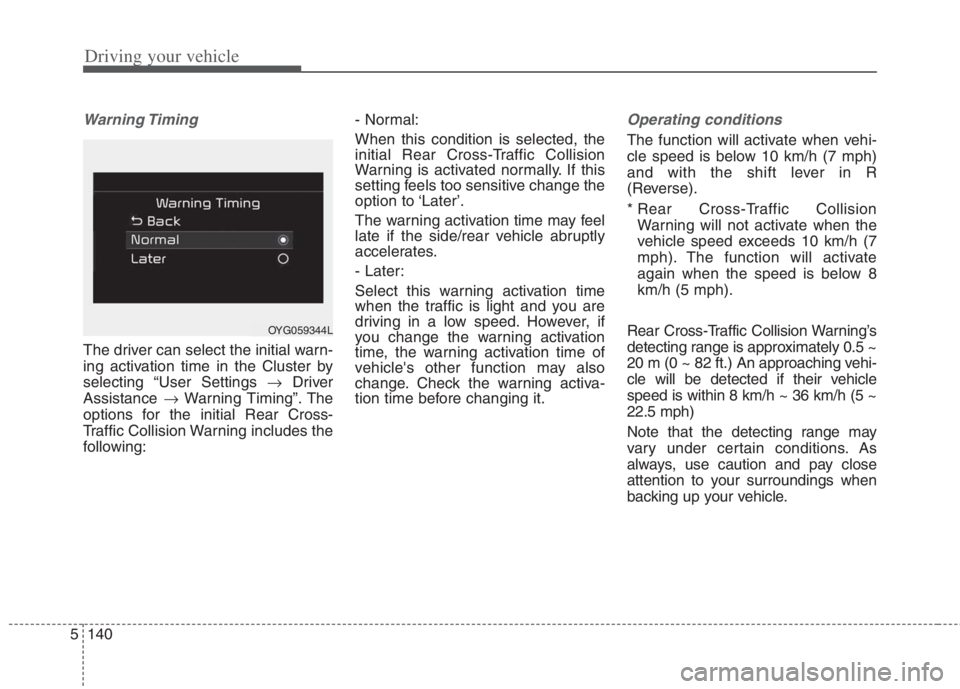
Driving your vehicle
140
5
Warning Timing
The driver can select the initial warn-
ing activation time in the Cluster by
selecting “User Settings Driver
Assistance Warning Timing”. The
options for the initial Rear Cross-
Traffic Collision Warning includes the
following: - Normal:
When this condition is selected, the
initial Rear Cross-Traffic Collision
Warning is activated normally. If this
setting feels too sensitive change the
option to ‘Later’.
The warning activation time may feel
late if the side/rear vehicle abruptly
accelerates.
- Later:
Select this warning activation time
when the traffic is light and you are
driving in a low speed. However, if
you change the warning activation
time, the warning activation time of
vehicle's other function may also
change. Check the warning activa-
tion time before changing it.
Operating conditions
The function will activate when vehi-
cle speed is below 10 km/h (7 mph)
and with the shift lever in R
(Reverse).
* Rear Cross-Traffic Collision
Warning will not activate when the
vehicle speed exceeds 10 km/h (7
mph). The function will activate
again when the speed is below 8
km/h (5 mph).
Rear Cross-Traffic Collision Warning’s
detecting range is approximately 0.5 ~
20 m (0 ~ 82 ft.) An approaching vehi-
cle will be detected if their vehicle
speed is within 8 km/h ~ 36 km/h (5 ~
22.5 mph)
Note that the detecting range may
vary under certain conditions. As
always, use caution and pay close
attention to your surroundings when
backing up your vehicle.
OYG059344L
Page 468 of 684
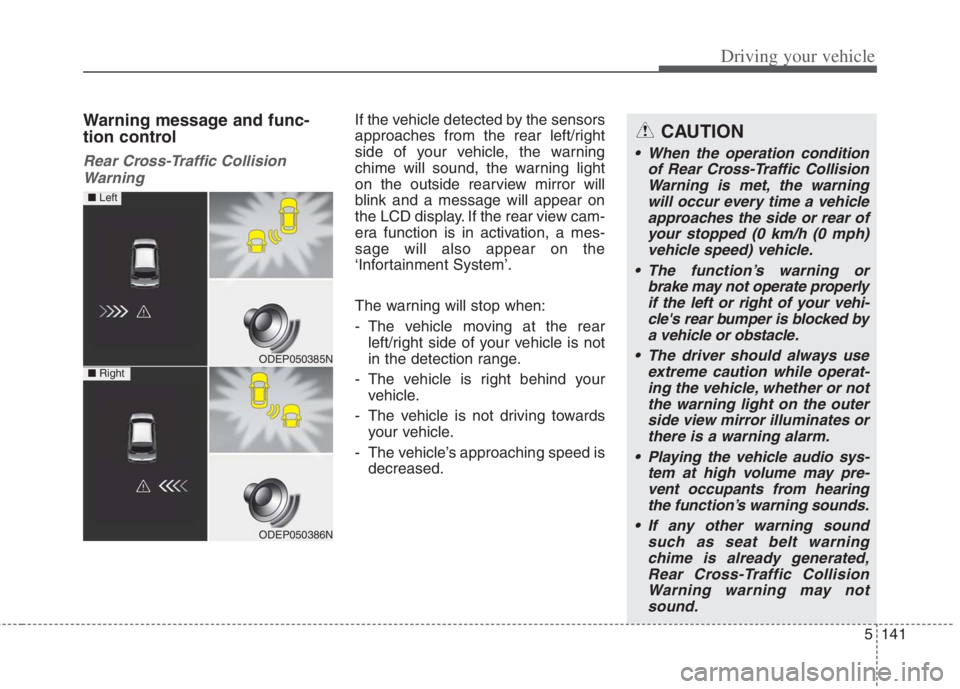
5141
Driving your vehicle
Warning message and func-
tion control
Rear Cross-Traffic Collision
Warning
If the vehicle detected by the sensors
approaches from the rear left/right
side of your vehicle, the warning
chime will sound, the warning light
on the outside rearview mirror will
blink and a message will appear on
the LCD display. If the rear view cam-
era function is in activation, a mes-
sage will also appear on the
‘Infortainment System’.
The warning will stop when:
- The vehicle moving at the rear
left/right side of your vehicle is not
in the detection range.
- The vehicle is right behind your
vehicle.
- The vehicle is not driving towards
your vehicle.
- The vehicle’s approaching speed is
decreased.CAUTION
When the operation condition
of Rear Cross-Traffic Collision
Warning is met, the warning
will occur every time a vehicle
approaches the side or rear of
your stopped (0 km/h (0 mph)
vehicle speed) vehicle.
The function’s warning or
brake may not operate properly
if the left or right of your vehi-
cle's rear bumper is blocked by
a vehicle or obstacle.
The driver should always use
extreme caution while operat-
ing the vehicle, whether or not
the warning light on the outer
side view mirror illuminates or
there is a warning alarm.
Playing the vehicle audio sys-
tem at high volume may pre-
vent occupants from hearing
the function’s warning sounds.
If any other warning sound
such as seat belt warning
chime is already generated,
Rear Cross-Traffic Collision
Warning warning may not
sound.
ODEP050385N
ODEP050386N
■ Left
■ Right
Page 469 of 684
![KIA NIRO HYBRID EV 2022 Owners Manual Driving your vehicle
142 5
Detecting sensors (Rear corner
radars)
[1] : Rear corner radars
The rear corner radars are located
inside the rear bumper for detecting
the side and rear areas.
Always keep KIA NIRO HYBRID EV 2022 Owners Manual Driving your vehicle
142 5
Detecting sensors (Rear corner
radars)
[1] : Rear corner radars
The rear corner radars are located
inside the rear bumper for detecting
the side and rear areas.
Always keep](/img/2/58909/w960_58909-468.png)
Driving your vehicle
142 5
Detecting sensors (Rear corner
radars)
[1] : Rear corner radars
The rear corner radars are located
inside the rear bumper for detecting
the side and rear areas.
Always keep the rear bumper clean
for proper operation of the function.
ODEP051158
CAUTION
Rear Cross-Traffic Collision
Warning may not work proper-
ly when the bumper has been
damaged, or if the rear
bumper has been replaced or
repaired.
Rear Cross-Traffic Collision
Warning may turn off due to
strong electromagnetic waves.
Always keep the sensors clean.
Never arbitrarily disassemble
the sensor component nor
apply any impact on the sen-
sor component.
Be careful not to apply unnec-
essary force on the radar sen-
sor or sensor cover. If the sen-
sor is forcibly moved out of
proper alignment, the function
may not operate correctly. In
this case, a warning message
may not be displayed.
(Continued)
WARNING
Drive safely even though the
vehicle is equipped with Rear
Cross-Traffic Collision
Warning. Do not solely rely on
the function but check your
surrounding when backing
the vehicle up.
The driver is responsible for
accurate brake control.
Always pay extreme caution
while driving. Rear Cross-
Traffic Collision Warning may
not operate properly or
unnecessarily operate
depending on traffic and driv-
ing conditions.
Page 470 of 684
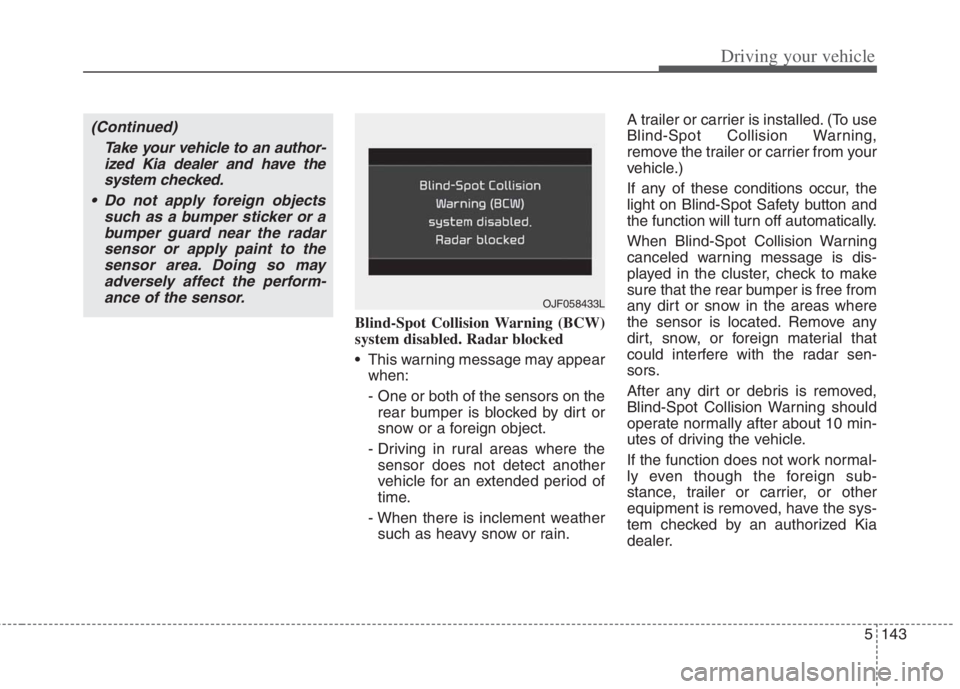
5143
Driving your vehicle
Blind-Spot Collision Warning (BCW)
system disabled. Radar blocked
This warning message may appear
when:
- One or both of the sensors on the
rear bumper is blocked by dirt or
snow or a foreign object.
- Driving in rural areas where the
sensor does not detect another
vehicle for an extended period of
time.
- When there is inclement weather
such as heavy snow or rain.A trailer or carrier is installed. (To use
Blind-Spot Collision Warning,
remove the trailer or carrier from your
vehicle.)
If any of these conditions occur, the
light on Blind-Spot Safety button and
the function will turn off automatically.
When Blind-Spot Collision Warning
canceled warning message is dis-
played in the cluster, check to make
sure that the rear bumper is free from
any dirt or snow in the areas where
the sensor is located. Remove any
dirt, snow, or foreign material that
could interfere with the radar sen-
sors.
After any dirt or debris is removed,
Blind-Spot Collision Warning should
operate normally after about 10 min-
utes of driving the vehicle.
If the function does not work normal-
ly even though the foreign sub-
stance, trailer or carrier, or other
equipment is removed, have the sys-
tem checked by an authorized Kia
dealer.
OJF058433L
(Continued)
Take your vehicle to an author-
ized Kia dealer and have the
system checked.
Do not apply foreign objects
such as a bumper sticker or a
bumper guard near the radar
sensor or apply paint to the
sensor area. Doing so may
adversely affect the perform-
ance of the sensor.